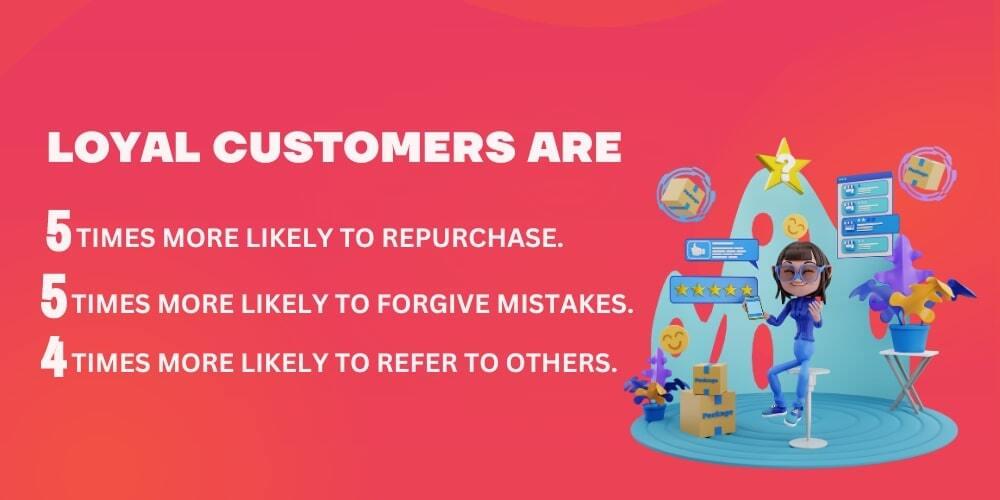
Why Customer Retention Should be a Priority for Every Business?

In a world full of AI-generative competing human intuition—keeping your users engaged to your products for longer period has become an absolute necessity.
It seems odd metrics analyzing human desires and calculating “churn” seem dehumanizing—as the reality of customer churn is that the people are rejecting you, and rejection hurts!
Its high time to dig deep into exploring customer relationships to offer more exceptional user service and value-added products/services that can transform their lives.
Metrics that determine customer churn are just the tools that highlights the causes of why and what made your customer go away and help you improve your relationship with your angry customers. Customer retention importance carries various reasons read out on all the reasons that can help you achieve your business goals better.
Why prioritizing customer retention importance is an absolute necessity for your business?
Facts tell that bringing an angry customer back is much easier than influencing new customers to use your product/services—acquiring a new customer takes up 5 times more cost.
Therefore, retaining your users for longer is the key—marketers can decrease their marketing expenses and enhance their profitability.
Influencing existing users to purchase additional products and services is easier. As they have used your products before and would like to give-a-try to your other products as well.
It can happen easily if you have maintained a good relationship with your users and have gained their confidence and loyalty. It seems dreamy for hundreds of startups, but the success of pioneers has proven that it can be possible to achieve with continuous effort.
Thirdly, Your existing customers are the key to enhancing the overlook of your brand. They may prove to be a good help in attracting new customers through positive word-of-mouth referrals.
Happy customers are more likely to recommend your products to their friends and family, leading to increased brand awareness and customer acquisition.
Finally, customer retention importance share long-term growth and sustainability. By establishing strong relationships with customers and focusing on their needs and preferences, businesses can create a loyal customer base that will continue to generate revenue and support the business over time.

Customer acquisition or customer retention—what’s more important?
Customer retention is keeping your user engaged to your business, while customer acquisition requires wooing a new user by using a plethora of tactics, cost, and time.
Both customer acquisition and retention are essential for business success, but they serve different purposes. Customer acquisition is crucial for businesses that want to expand their customer base and increase their revenue, and it is a crucial first step in building a successful business.
Customer retention is important for businesses looking to build long-term relationships with their customers, create a sustainable growth strategy, and save costs. Existing customers are more likely to make repeat purchases and refer new customers to the business.
Uncovering the benefits of maintaining a base of loyal customers.
There are a plethora of ways to keep winning the hearts of your users.
But in these ambiguous times, when the competition is fiercer than ever, you may need to turn all stones to retain users for a longer time. You must ensure that the ties for perfect customer relations remain intact.
You may survive by offering average customer service, but they should be better than your competitors.
Last and most importantly, keep evolving and offering value-added products/services. We all know customer retention’s importance that can significantly affect a business’s bottom line.
In this blog, you will learn the practical reality of customer retention importance and how AI metrics can help you achieve perfect customer relationships.

The business that is successful in achieving a perfect customer retention ratio observes increased revenue. You save the cost of retaining users as acquiring new users is more expensive, and existing customers are more likely to make repeat purchases and spend more over time. In a nutshell, when fewer customers are leaving, revenue doubles up.
The efforts that are made to save the cost never go futile. Acquiring new customers can be costly due to advertising, marketing, and other forms of outreach. By retaining existing customers, businesses can save on these costs and allocate resources more effectively.
Satisfied customers are more likely to refer new customers to a business, which can lead to increased brand advocacy and word-of-mouth marketing. This can help build a positive business reputation and attract new customers.
Retaining existing customers also allows businesses to gather valuable feedback and insights about their products or services. This feedback can improve the customer experience and create better products and services over time.
Businesses that can retain their customers over the long term have a competitive advantage over those constantly acquiring new customers. They are more likely to have a loyal customers and a strong brand reputation, which can help to differentiate them from their competitors.
Understanding the consequences of increased customer churn.
Losing customers can be costly for a business, and not knowing why they leave is a bigger risk.
Ambiguity is the enemy with the capability of stealth attack your business can never afford.
The customer retention-friendly tools help you see through the veil of this ambiguity and let you know what immediate remedies you can take before it’s too late.
No proper actions taken at the right time may become the cause of losing a customer forever. When customers leave, they take their business elsewhere, resulting in losing them forever.
And, if the tale of an angry customer remains a mystery, there are bigger chances other users may leave for the same reason—and you are still looking for an answer.
Constantly acquiring new customers to make up for the ones they are losing can be costly and time-consuming. This can put a business at a competitive disadvantage.
Businesses lose valuable feedback and insights into their products and services when customers leave, making it more difficult for them to improve their offerings and meet the needs of their remaining customers.
Dissatisfied customers are more likely to share their negative experiences with others, which can lead to negative word-of-mouth marketing and a loss of trust in the business.
Customer churn measuring tools are important in informing you as they ring the danger bell at the right time. You still get the time to inquire about the problems that made your customer leave. An angry customer always gives the most honest review of the problems they faced. You still have time to resolve their problems and make them stay.
Churnfree is a retention-friendly tool helping subscription-based businesses save their customers from leaving every day. You can also use their feedback to a large relative audience. This way, you can influence people about your brand at a deeper and emotional level. The data delivered by Churnfree can save a lot of money—as it helps improve your retention rate and acquire new customers.
A good customer retention can have a significant impact on a business, including increased revenue, less costs, enhanced brand reputation, valuable customer feedback, and a competitive advantage.
Uncovering proven techniques to boost customer loyalty and keep them coming back for more.
If you run a SAAS business, it’s important to focus on retaining your customers for long-term success. It’s more difficult and costly to acquire new customers than to keep the ones you already have. To achieve this, it’s crucial to develop effective B2B SAAS customer retention strategies. The following strategies can give you an overview of retention strategies for your business.
1. Establishing clear and unequivocal expectations
Transparency is the key to achieving so many things, and winning a customer is one of its important things. It’s important to be upfront about what your service can offer customers to prevent unmet expectations. Make sure to clearly communicate the value of your service and slightly under-promise on what you can deliver. This way, you can exceed their expectations and delight them.
2. Experience the “Eureka” moment.
To ensure long-term customer retention, it’s important to have a smooth onboarding process. Once a customer signs up, your priority should be to capture their attention and provide value without any issues.
You can achieve this by sending instructional content to help users become familiar with your service and its features. If your service is complex, offering free training can be beneficial.
Ultimately, your goal should be to guide the user towards the “A-Ha” moment, when they realize the value your service adds to their life.
By optimizing your onboarding process, you can make a lasting impression on your customers and establish a strong foundation for your long-term customer retention strategy.
3. Emphasize the Unique Benefits You Offer
Your product’s value proposition is what distinguishes it from competitors. It’s important to have a clear and concise value proposition to quickly communicate the benefits to users.
Delivering on your value proposition helps retain customers who initially signed up for your service. By emphasizing your value proposition, you can set your service apart from competitors and build a loyal customers base. Regularly reminding users of the value they gain by using your service encourages them to continue their subscription.
4. Upsell
Upselling is a highly effective strategy for retaining customers in the SAAS industry. Not only does it generate additional revenue, but it also strengthens the relationship with the customer.
Long-term customers who recognize the value of your service are more likely to invest in additional features or services that address their needs, which can address several customer pain points and increase their loyalty towards your service.
Furthermore, offering personalized deals to long-term customers can further deepen the relationship and encourage them to stay with your business for the long haul.
5. Sending personalized tips is a proven method to boost engagement.
To ensure your customers get the most out of your product or service, sending personalized and targeted tips can be very helpful. One way to do this is by setting up automated emails triggered by specific actions, such as designing a sales page.
When users accomplish this task, you can congratulate them and offer tips on how to optimize their page. By providing useful information that adds value to their efforts, you can increase engagement and encourage them to stay longer.
Wrapping up:
To effectively implement SAAS customer retention strategies, your business framework must strike a balance between offering a flexible user experience and efficient business processes. This will promote timely action before it’s too late. Achieving this requires multiple systems working seamlessly together, including payment processors, subscription billing and management logic, customer churn calculation tools, customer feedback, sales tax compliance, reporting functionality, and customer support systems.
SAAS customer retention is all about valuing your users’ time and concerns while delivering a rewarding experience. By recognizing your users’ needs and providing exceptional customer service, you can foster their satisfaction and loyalty. Do you have any preferred user retention strategies?
For businesses seeking to enhance their customer retention rates, we suggest the following:
- Providing outstanding customer service is a crucial aspect that cannot be overlooked.
- Enhance the customer experience with personalized touches.
- Encourage loyalty by offering rewards
- seek feedback from your esteemed customers.
- Strive for constant improvement.
- It is imperative that you uphold consistent communication with your customers

